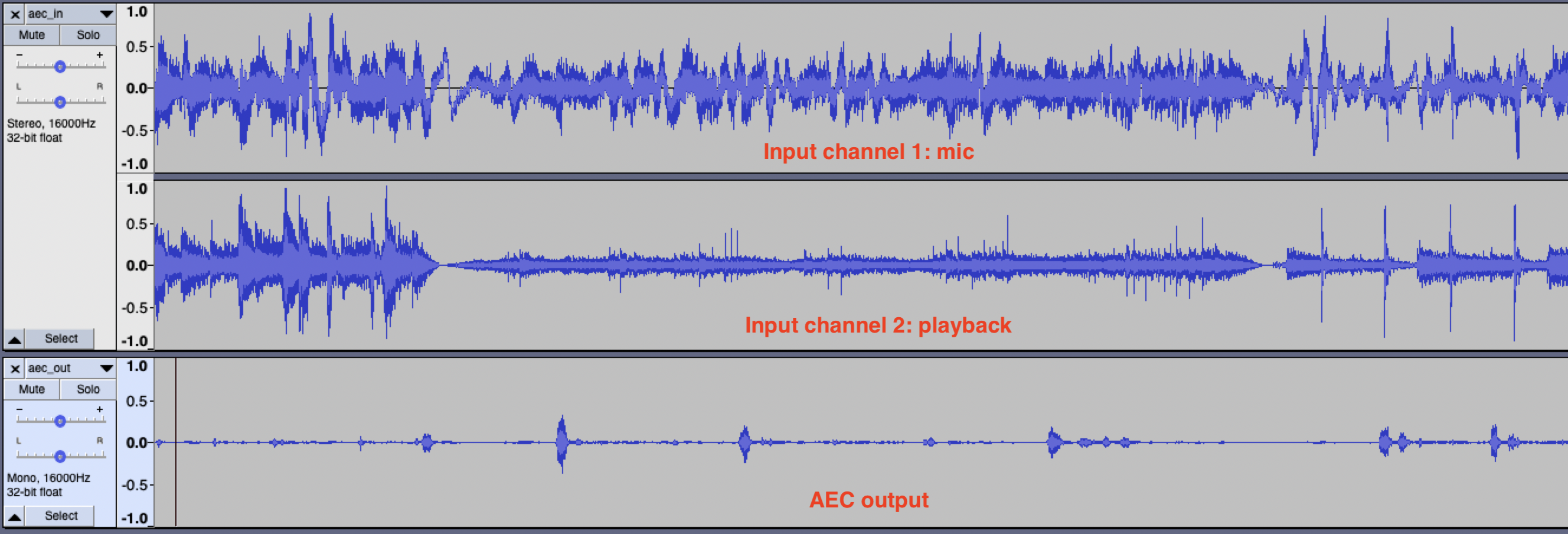The target of this project is to integrate and use two amazing pretrained models DTLN and DTLN-aec on Raspberry Pi for realtime noise suppression (NS) and/or acoustic echo cancellation (AEC) tasks.
This is simple as the DTLN project already provides a realtime script for handling data from/to audio devices.
I add a few useful options in the ns.py based on the orginal script. See --help for details.
- Enable
snd-aloopwithsudo modprobe snd_aloop. You may want to add a linesnd-aloopin/etc/modulesto automatically enable it on boot. - Now check
arecord -l, you should able to see two new Loopback devices. - Run DTLN with
python3 ns.py -o 'Loopback ,0' --measure, you should see processing times < 4ms. If your processing time is longer you may need a more powerful device. If you see a lot of "input underflow" try to adjust the latency for a higher value, e.g.,--latency 0.5. - Run
arecord -D hw:Loopback,1 -f float_le -r 16000 -c 1 -V mono rec.wavin a separate shell to record denoised audio. Then listen to it or open with Audacity. You should noice obvious noise removal and clear voice.
- Copy
ns.pyto/usr/local/bin/nsandchmod +x. - Add the dtln_ns.service to
/etc/systemd/user/and enable it withsystemctl --global enable dtln_ns - Reboot and record some audio from
hw:Loopback,1to see if DTLN NS is running and taking effect.
This is based on the DTLN-aec project. It currently only has a file-based demo script with tflite (not quantized) models. To make it realtime, I converted models to quantized models and created two realtime scripts:
models/dtln_aec_???_quant*are quantized models.???is the number of LSTM units, larger means slower but supposed to be better.aec.pytakes a pair of devices as input and output. It assumes the input device contains a channel as loopback/reference.aec_mp.pyis a multiprocessing version, it runs close to 2x faster on 256/512 models.
You need to have a sound card which supports hardware loopback, and the loopback is on the last channel of captured audio. In my case is the Respeaker USB Mic Array V2.0, which has 6 input channels and the last one is the playback loopback.
- List devices with
python3 ns.py -l. Note down a unique substring of your soundcard's name. In my case it can be "UAC1.0". - Test with
python3 ns.py -i UAC1.0 -o UAC1.0 -c 6 -m 128. Speak to your mic, you should hear no feedback echo. - Follow the similar procedure in DTLN NS setup to put AEC output to a virtual capturing device. So you can use it in other programs.
When you don't have a soundcard that supports hardware loopback, you need to create a virtual input device whose last channel stores playback loopback. I made a ALSA AEC plugin that can achieve this. Refer to the instruction there to setup and configure, then you will have two additional alsa interfaces: aec and aec_internal. To use them, simply do:
- Play some music to AEC virtual device:
aplay -D aec music.wav - Run AEC script with:
python3 aec.py -m 128 -i aec_internal -o aec_internal. - Record from AEC virtual device:
arecord -D aec -f S16_LE -r 16000 -c 1 -V mono rec.wav
Now look at recorded audio file, music should be removed.
For testing, you may also use the --save option to save input audio to /tmp/aec_in.wav and AEC output to /tmp/aec_out.wav for inspection. Below is an sample input/output with my ReSpeaker 2-Mics Pi HAT (run with 256 model).
This table is the evaluation of processing time on my Raspberry Pi 3B+ with 64bit OS. Note that all DTLN models were trained with block of 128 samples. Under the sample rate 16000, that is 8ms. So the processing time must be below 8ms to work realtime.
| Model | ns.py |
aec.py |
aec_mp.py |
|---|---|---|---|
| 128 | N/A | 4.43 ms | 2.52 ms |
| 256 | N/A | 6.36 ms | 3.76 ms |
| 512 | 2.56 ms | 12.35 ms | 8.48 ms |
In my experience, it's better to use models < 5ms, otherwise you may see some "output underflow" messages (sometimes increase --latency may help).
- The
aec_mp.pyscript usesmultiprocessing.shared_memory, which requires Python 3.8+. If you are using an older version of Python, please dopip3 install shared-memory38first to install the backport module. - If
pyfftwis installed, the script will usepyfftwinstead ofnp.fft, which can gives a negligible ~0.2ms speedup. Note that inaec_mp.py, the processing time is capped byinterpreter2inference time so fft processing time in the parallel process doesn't matter. - One huge benefit of DTLN AEC comparing to traditional AEC is that it's more robust. It can work even when the input has gone through other preprocessing stages like NS or another AEC. Also it can adapte to different delays so you may try it with bluetooth speaker.
- The DTLN NS can also attenuate most of the background music the model is faster and more stable comparing to 128/256 AEC models. Sometimes I notice my voice is also attenuated by AEC models. So traditional (hardware) AEC + DTLN NS may work better in practice.
- If your see strange alsa errors or a lot of xruns, try
sudo apt install libasound2-pluginsthen add the linedefaults.pcm.rate_converter "samplerate"in/etc/asound.conf.
- This project is heavily based on the DTLN and DTLN-aec projects by breizhn.
- Thanks StuartIanNaylor for the discussion and help on various topics ranging from the idea of multiprocessing and trouble shooting alsa configs.
- Kudos to the cool tool tflite2tensorflow made by PINTO0309. I used it to convert DTLN-aec tflite models to quantized version.
